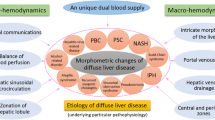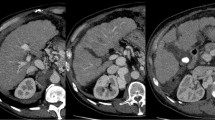Abstract
For a better understanding of the formal pathogenesis of liver cirrhosis, the angioarchitecture of the liver lobule in chronic viral hepatitis was investigated three dimensionally. The histological reconstruction method, using serial histological sections, was adopted for the three-dimensional observation. Histology of the case showed chronic active hepatitis with occasional fibrous bridging of the portal to portal tract or hepatic vein. Graphic reconstructions revealed various degrees of altered angioarchitecture from place to place. While the conducting portion of the portal vein was almost preserved, the pathological changes mostly began at the parenchymal portion, especially second step or subsequent branches of the portal vein. In general, portal vein branches showed damage such as stenoses, disappearance, an increase and decrease in number and distorted spatial arrangements. Even in less damaged portal tracts, portal veins showed such changes to some extent. In severely damaged places with bridging fibrosis, a normal lobular angioarchitecture was completely lost; instead, portal veins, arteries and hepatic veins were tangled with each other. Parenchymal nutrition was suggested to be dependent on the remaining third-step portal branches or newly formed ones. However, the hepatic vein system had a tendency to be preserved and distributed fluently in the parenchyma. The distortion of these portal vessels indicated various degrees of loss of the lobular architecture. In conclusion, it is suggested that an early histological sign of cirrhosis develops in the course of chronic hepatitis.










Similar content being viewed by others
References
Anthoney PP, Ishak KG, Nayak NC, Poulsen HE, Scheuer PJ Sobin LH (1978) The morphology cirrhosis. J Clin Pathol 31:395–414
Baggenstoss AH, Solway RD, Summerskill WHJ, Elveback LR, Schoenfield LJ (1972) Chronic active liver disease Hum Pathol 3:183–198
Chen TJ, Liaw YF (1988) The prognostic significance of bridging hepatic necrosis in chronic type B hepatitis: a histopathologic study. Liver 8:10–16
Cooksley WGE, Bradbear RA, Robinson W, Harrison M, Halliday JW, Powell LW, Ng HS, Seah C-S, Okuda K, Scheuer PJ, Sherlock S (1986) The prognosis of chronic active hepatitis without cirrhosis in relation to bridging necrosis. Hepatology 6:345–348
Hano H (1979) Three-dimensional approach to the angioarchitecture in a cirrhotic liver of alcoholic origin. Jikeikai Med J 94:1–12
Hayashi H (1989) Angioarchitectural changes in a mixed nodular cirrhotic liver. Acta Hepatologica Japonica 30:1687–1697
Jones AL, Spring-Mill E (1983) The liver and gall bladder. In: Weiss L (ed) Histology, 5th edn. McMillan, New York, pp 707–748
Kiernan F (1833) The Anatomy and physiology of the liver. Philos Trans R Soc Lond B Biol Sci 123:711–770
Kretz R (1900) Ueber Lebercirrhose. Wien Klin Wochenschr 13:271–276
Kretz R (1905) Cirrhosis of the liver. Int Clin 3:289–297
Magara T (1986) Three-dimensional characteristic of B' type cirrhosis, with special reference to its angioarchitecture. Jikeikai Med J 101:579–602
Mall FP (1906) A study of the structural unit of the liver. Am J Anat 5:227–308
Mann JD, Wakim KG, Baggenstoss AH (1953) Alterations in the vasculature of the diseased liver Gastroenterology 25:540–546
Matsumoto T, Kawakami M (1982) The unit concept of hepatic parenchyma- a reexamination based on angioarchitectural studies. Acta Pathol Jpn 32:285–314
Matsumoto T, Komori R, Magara T, Ui T, Kawakami M, Tokuda T, Takasaki S, Hayashi H, Jo K, Hano H, Fujino H, Tanaka H (1979) A study on the normal structure of the human liver, with special reference to angioarchitecture. Jikeikai Med J 26:1–40
McCallum WG (ed) (1940) A textbook of Pathology, 7th edn. W.B. Saunders Company, Philadelphia, pp 298–322
McIndoe AH (1946) Vascular lesions of portal cirrhosis. Arch Pathol Lab Med 5:23–42
Mitra SK (1966) Hepatic vascular changes in human and experimental cirrhosis. J Pathol Bacteriol 92:405–414
Moschcowitz E (1948) Lannec cirrhosis: its histogenesis with special reference to the role of angiogenesis. Arch Pathol 45:187–215
Nakamura T, Nakamura S, Suzuki T (1961) Study on cirrhosis of the liver: structure of shunted blood vessel in the autopsied cirrhotic liver. Tohoku J Exp Med 75:1–9
Popper H (1977) Pathologic aspects of cirrhosis: a review. Am J Pathol 87:228–264
Popper H, Elias H (1955) Histogenesis of hepatic cirrhosis studied by the three-dimentional approach. Am J Pathol 31:405–441
Popper H, Elias H, Petty DE (1952) Vascular pattern of the cirrhotic liver. Am J Clin Pathol 22:717–729
Rappaport AM, Borowy ZJ, Longheed WM, Lotto WN (1954) Subdivision of hexagonal liver lobules into a structural and functional unit. Anat Rec 119:11–33
Rappaport AM, MacPhee PJ, Fisher MM, Phillips MJ (1983) The scarring of the liver acini (Cirrhosis). Tridimentional and microcirculatory considerations. Virchows Arch 402:107–137
Author information
Authors and Affiliations
Corresponding author
Rights and permissions
About this article
Cite this article
Hano, H., Takasaki, S. Three-dimensional observations on the alterations of lobular architecture in chronic hepatitis with special reference to its angioarchitecture for a better understanding of the formal pathogenesis of liver cirrhosis. Virchows Arch 443, 655–663 (2003). https://doi.org/10.1007/s00428-003-0843-x
Received:
Accepted:
Published:
Issue Date:
DOI: https://doi.org/10.1007/s00428-003-0843-x




